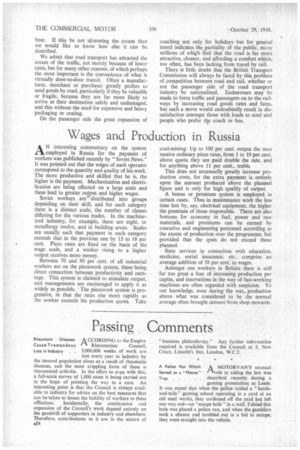Wages and Production in Russia
Page 26

If you've noticed an error in this article please click here to report it so we can fix it.
AN interesting commentary on the system employed in Russia for the payment of workers was published recently by "Soviet News." It was pointed out that the wages of each operator correspond to the quantity and quality of his-work. The more productive and skilled that he is, the higher is the payment. Mechanization and electrification are being effected on a large scale and these lead to greater output and higher wages. Soviet workers area distributed into groups depending on their skill, and for each category there is a distinct scale, the number of classes differing for the various trades. In the machinetool industry, for, example, there are eight, in metallurgy twelve, and in building seven. Scales are usually such that payment in each category exceeds that in the previous one by 15 to 18 per cent. Piece rates are fixed on the basis of the wage scale, and a worker rising to a higher output receives more money.
Between 70 and 80 per cent, of all industrial workers are on the piecework system, there being direct connection between productivity and earnings. This system is claimed to stimulate output, and managements are encOuraged to apply it as widely as possible. ' The piecework system is progressive, in that the rates rise more rapidly as the worker exceeds his production quota. Take coal-mining: Up to 100 per cent. output the men receive ordinary piece rates, front 1 to 10 per cent. above quota they are paid double the rate, and for anything above 11 per cent., treble.
This does not necessarily greatly increase production costs, for the extra payment is entirely upon the amount produced above the planned figure and is only for high quality of output.
A bonus or premium system is employed in certain cases. Thus in maintenance work the less time lost by, say, electrical equipment, the higher the premium of those responsible. There are also bonuses for economy in fuel, power and raw materials, and premiums can be earned by executive and engineering personnel according to the excess of production over the programme, but provided that the costs do not exceed those planned.
State services in connection with education, medicine, social insurance, etc., comprise an average addition of 38 per cent, to wages.
Amongst our, workers in Britain there is still far too great a fear of increasing production per capita, and innovations in the way of fast-working machines are often regarded with suspicion. To our knowledge, even during the war,, production above what was considered to be the normal average often brought censure from shop stewards.




















































































